
Transport in Argentina is mainly based on a complex network of routes, crossed by relatively inexpensive long-distance buses and by cargo trucks. The country also has a number of national and international airports. The importance of the long-distance train is minor today, though in the past it was widely used and is now regaining momentum after the re-nationalisation of the country's commuter and freight networks. Fluvial transport is mostly used for cargo.

Once railway station is a large railway terminus in central Buenos Aires, Argentina, in the barrio of Balvanera.

Trenes de Buenos Aires (TBA) (In English: Trains of Buenos Aires) was a private company that operated commuter rail services over the 5 ft 6 in (1,676 mm) broad gauge Sarmiento and Mitre lines of Buenos Aires. The company, owned by Claudio and Mario Cirigliano, also operated long-distance services on the General Mitre Railway to central-western Argentina and on the General Urquiza Railway to northern Argentina and Uruguay on the international Tren de los Pueblos Libres.

The Sarmiento line is a broad gauge commuter rail service in Buenos Aires Province, Argentina, run by the state-owned Trenes Argentinos since 11 September 2013.

The San Martín line is a 70-kilometre (43 mi), 22-station commuter rail service in the metropolitan area of Buenos Aires, Argentina. The San Martín line operates from the city-centre terminus of Retiro north-west to Doctor Cabred in Luján Partido along a broad gauge line built by the British-owned Buenos Aires and Pacific Railway.

The Roca line is a 1,676 mm gauge commuter rail service in the Buenos Aires Province, Argentina, part of General Roca Railway network. The service is currently operated by State-owned company Trenes Argentinos, from the city-centre terminus of Constitución south to Ezeiza, Alejandro Korn, La Plata, Cañuelas, Chascomús, Gutiérrez and Lobos, and west to Sarmiento Line's station Haedo. The transfer stations between the branch lines are Avellaneda, Temperley, Bosques and Berazategui.

The Belgrano Sur line is an Argentine 1,000 mmmetre gauge commuter rail service in the Greater Buenos Aires area, currently operated by state-owned enterprise Trenes Argentinos. The Belgrano Sur runs over tracks and through stations built by the Franco–Belgian-owned Compañía General de Buenos Aires and British Midland companies at the beginning of the 20th century.
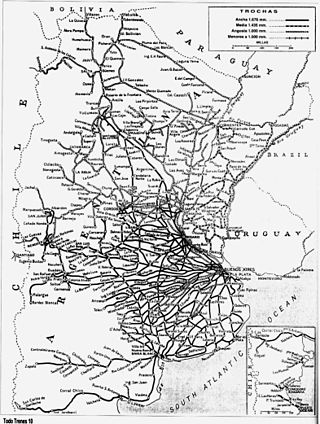
The Argentine railway network consisted of a 47,000 km (29,204 mi) network at the end of the Second World War and was, in its time, one of the most extensive and prosperous in the world. However, with the increase in highway construction, there followed a sharp decline in railway profitability, leading to the break-up in 1993 of Ferrocarriles Argentinos (FA), the state railroad corporation. During the period following privatisation, private and provincial railway companies were created and resurrected some of the major passenger routes that FA once operated.

Aníbal Florencio Randazzo in an Argentine Justicialist Party politician. He was Minister of the Interior and Transport during the presidency of Cristina Fernández de Kirchner, from 2007 to 2015. An ally of Kirchner's during most of his political career, Randazzo fell out with her and ran against her for a seat in the Senate in 2017.
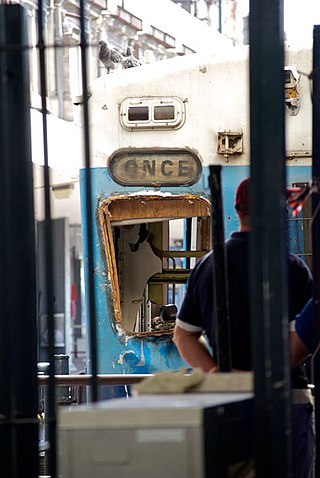
The 2012 Buenos Aires rail disaster, also known as the Once Tragedy, occurred on 22 February 2012, when a train crashed at Once Station in the Balvanera neighbourhood of Buenos Aires, Argentina.

Unidad de Gestión Operativa Mitre-Sarmiento (UGOMS) was a temporary consortium of Argentine companies formed on 24 May 2012 by Ferrovías and Metrovías to take over the running of the Sarmiento and Mitre commuter rail lines, after concessions granted to Trenes de Buenos Aires (TBA) in 1995 for the operation of these services were revoked.
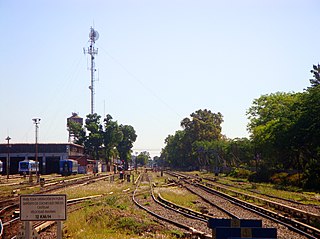
The 2013 Castelar rail disaster occurred on 13 June 2013 at about 07:30 local time, in the Castelar neigborhood of Morón Partido in Greater Buenos Aires area, about 30km west of the city of Buenos Aires, Argentina.

Operadora Ferroviaria Sociedad del Estado (SOFSE), trading as Trenes Argentinos Operaciones, is an Argentine state-owned company created in 2008 to operate passenger services in Argentina. It operates as a division of Ferrocarriles Argentinos S.E..

Broad Front UNEN was an center-left political coalition in Argentina. It arose through an alliance between Radical Civic Union, Civic Coalition ARI, Proyecto Sur, Freemen of the South Movement, Socialist Party, Authentic Socialist Party, and GEN.

Corredores Ferroviarios was an Argentine private company that operated the Mitre and San Martín railway services in Buenos Aires Province for about one year until the Government of Argentina rescinded the agreement with the company in March 2015. Since then, the Mitre and San Martín line are operated by State-owned company Operadora Ferroviaria Sociedad del Estado (SOFSE).
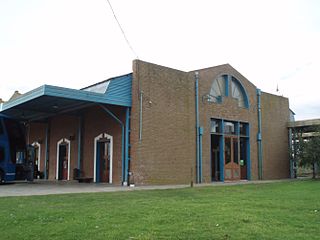
Chascomús is a railway station and bus terminus in the homonymous city of Buenos Aires Province, Argentina. Construction began on his station in 1983 when Raúl Alfonsín was President of Argentina but works were interrupted and finally cancelled until they were resumed in 2014 and the station was finished and opened to public on December 19. Station's facilities and services include railway platforms, bus garages, accessible toilets and a coffeehouse.

Mar del Plata is a railway and bus terminus in the homonymous city of Buenos Aires Province, Argentina. Opened in 2009 as a bus terminus only, the railway tracks from the old "Norte" station were extended to connect both terminals in 2011 by architect Claudio Luis Lucarelli, adding new platforms to receive trains from Buenos Aires.
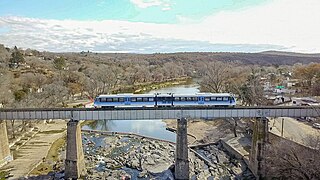
Tren de las Sierras is a 150.8 km (93.7 mi) regional rail line in Córdoba Province of Argentina. The line runs from Alta Córdoba to Capilla del Monte, being currently operated by state-owned company Trenes Argentinos Operaciones.

Alta Córdoba is a railway station located in the Alta Córdoba neighborhood of Córdoba in the province of the same name, Argentina. The station is terminus of the Tren de las Sierras service operated by state-owned Trenes Argentinos. Likewise, another state company, Trenes Argentinos Cargas y Logística, operates freight services there.

The CSR EMU is a series of electric multiple unit cars manufactured by CSR Corporation Limited for use on Buenos Aires' commuter rail network. As of 2015, the trains operated on three of the city's lines and 705 cars were manufactured, with each line using a different number of cars per train. They were created for use on lines electrified using both third rail and overhead lines.






















